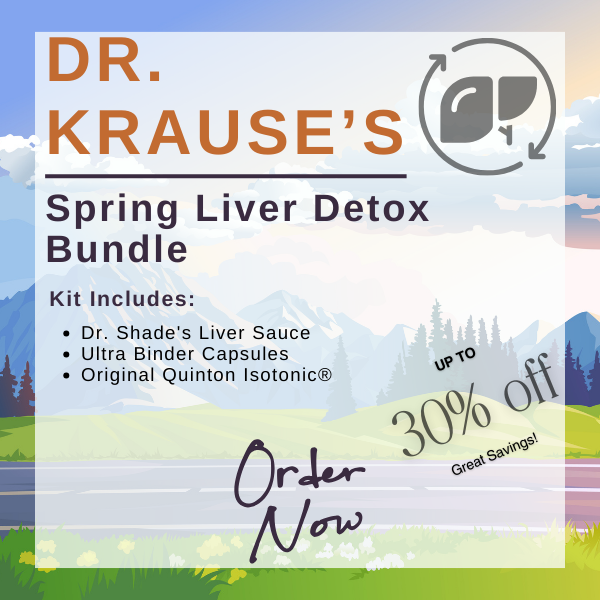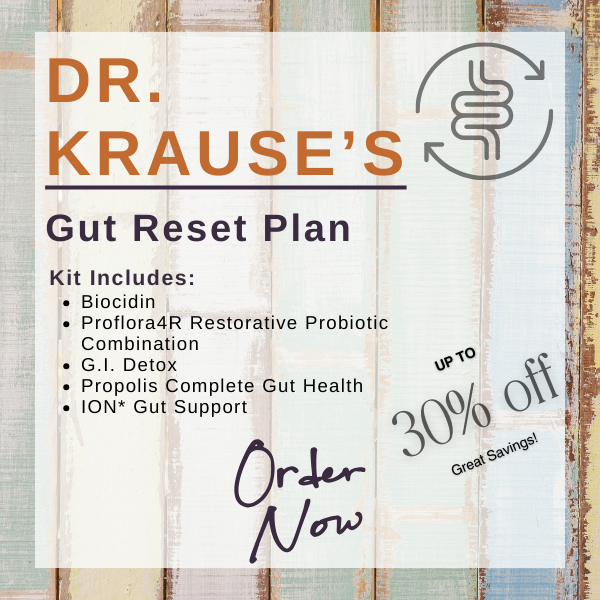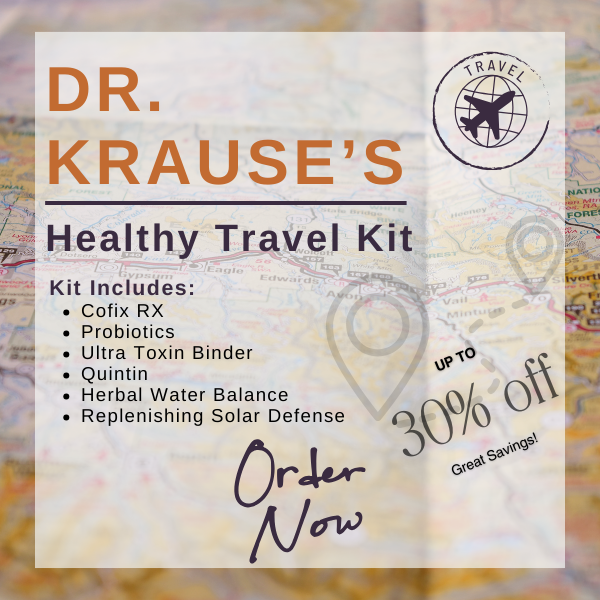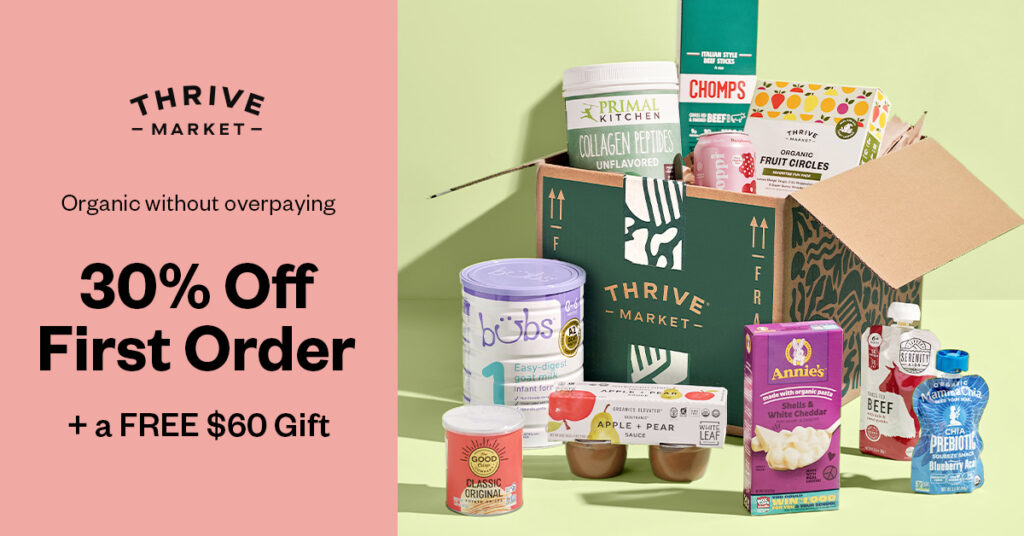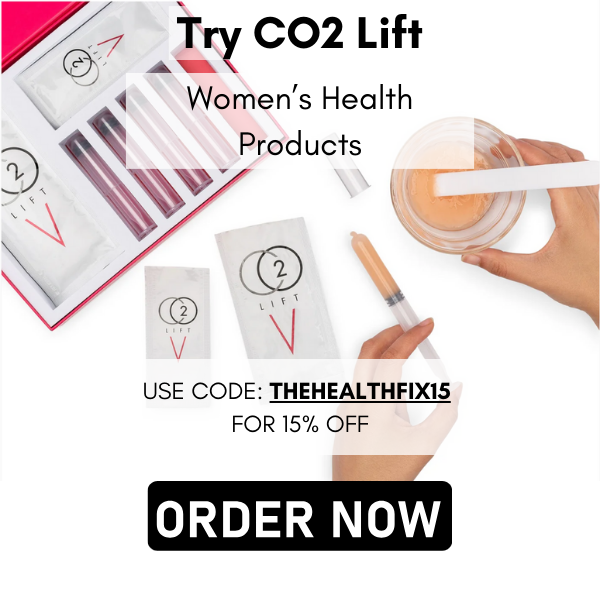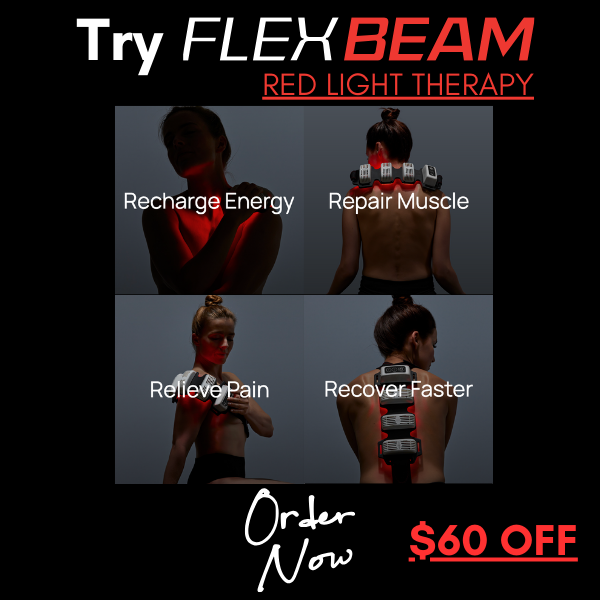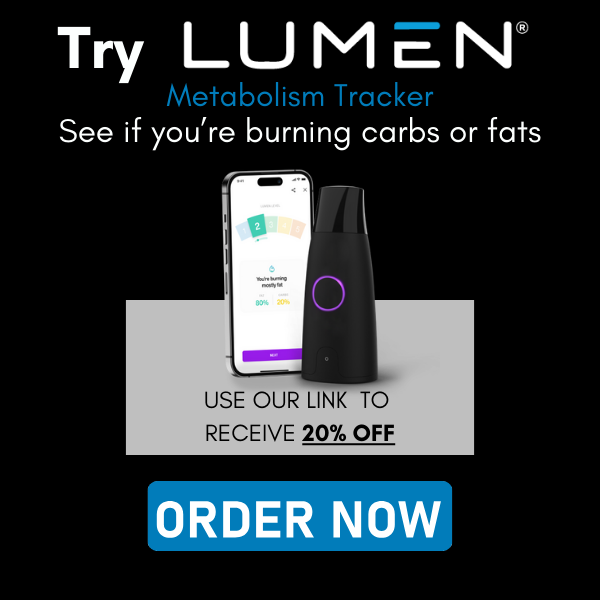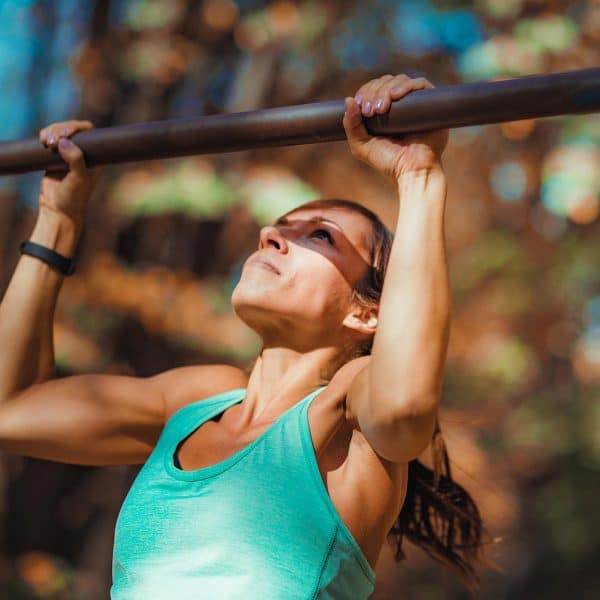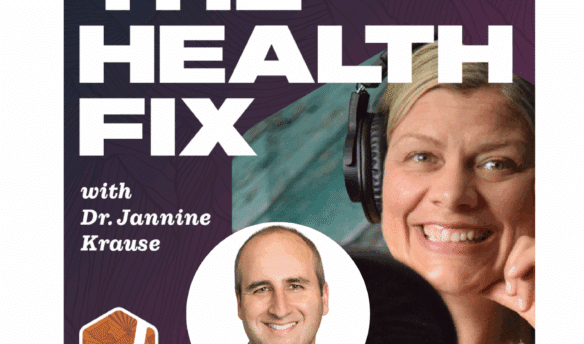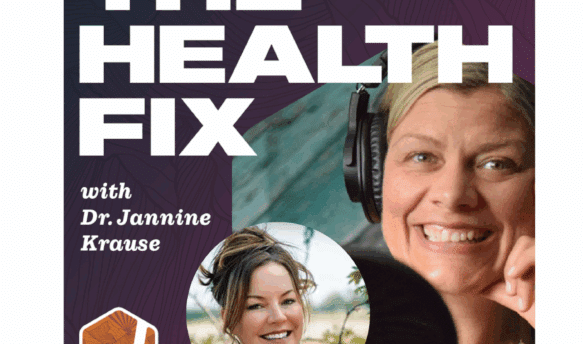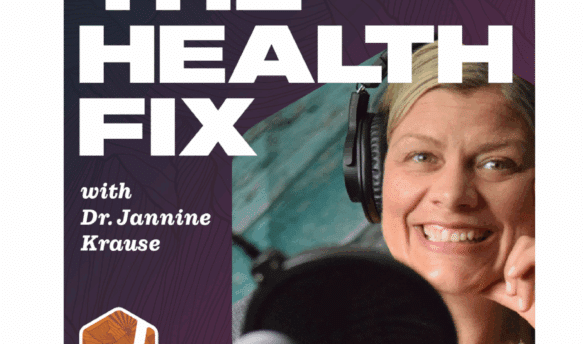Struggling with your hormones? Feeling burn out, fatigued and just not your best? Kaely McDevitt is a registered dietician specializing in nutrition for women’s health. Having experienced the pitfalls of a conventional approach to women’s health first hand, Kaely is passionate about empowering women to build health from a place of connection: to self, nature and community. In this episode of The Health Fix Podcast, Dr. Jannine Krause interviews Kaely McDevitt, RD on how minerals are the MVP when it comes to feeling your best, preventing or addressing burnout.
Dr. Krause’s Protocols
Instructions Included
Traveling soon? Looking to detox or reset your gut? Try one of Dr. Krause’s Fullscript plans.
What You’ll Learn In This Episode:
- How calcium and potassium balance is connected to hypothyroid symptoms
- Why minerals can boost energy and fire up metabolism
- Connection between sodium, potassium and fatigue
- What you can learn from hair tissue mineral analysis
- Why minerals are crucial for hormone balancing
Resources From The Show:
- Trace elements – Hair Tissue Mineral Analysis (HTMA) example
- Instagram – @kaelyrd
- Kaely’s Website – https://www.kaelyrd.com/
- Find Your Magic Quiz
Our Partners
Podcast Transcript
1:44 – Kaely’s story
5:00 – Using birth control to alleviate menstrual cramps
9:17 – What Kaely is testing her patients for
10:46 – Why Kaely starts with mineral testing
12:24 – Most common deficient minerals found and typical client served in Kaely’s practice
14:45 – Next step, food, beverage and possibly supplementation
17:42 – Understanding calcium
24:21 – What are the red flags in the testing results if the issue is the water?
28:02 – Trends in perimenopause women
29:36 – How to get functional testing done and find some support
32:22 – Working with Kaely
33:44 – How Kaely approaches the nutrient and fitness aspect of getting healthy
35:38 – If stranded on an island, what 3 foods would Kaely bring with and why
37:12 – Dairy in the diet
39:33 – Testing things to see if it works for you
43:29 – Where to find Kaely online
[Intro] Welcome to the Health Fix Podcast, where health junkies get their weekly
fix of tips, tools, and techniques to have limitless energy, sharp minds, and fit
physiques for life.
Hey Health Junkies, on this episode of the Health Fix Podcast, I’m interviewing
Kaely McDevitt. She’s a registered dietitian specializing in nutrition for
women’s health. And today we’re going to be talking about minerals and the role
that minerals play in balancing hormones, in energy, in thyroid metabolism,
thyroid metabolism and metabolism in general.
This is a fun podcast and we geek out on hormones big time.
So you’re definitely going to learn something in this podcast.
So let’s introduce you to Kaely McDevitt.
Hey, health junkies.
I have Kaely McDevitt on and we’re going to be talking about food.
We’re going to be talking about minerals.
We’re going to be talking about all the things that we kind of overlook when it
comes to the basics of helping you balance your hormones, health, life in general.
So Kaely, welcome to Health Fix Podcast.
KAELY: Thank you so much for having me.
I’m pumped to be here.
JANNINE: Well, gosh, before I hit record,
I kind of was like, you kind of do all the things
I need help with in my practice.
All the things that we’re working on with patients
and you’ve got kind of the foundation.
And sometimes, you know, as Doc’s,
it’s hard for us to do that underlying coaching.
And this is where I love looking to our Ds that are,
let’s say awake to what’s legit nutrition.
So of course, I always have to ask,
you went to the traditional schooling, I saw that in your website about your history.
And then you were like, oh wait, I’m missing something.
Give us kind of the backstory in terms of how that evolution came out.
And were you always interested in nutrition as a kid?
KAELY: Yeah, you know, I knew I would do something in the health space.
My mom was a physical therapist.
I was an athlete.
I was like, you know, it’ll be something in that space.
And I think I maybe it was a sophomore and undergrad when I realized that
dietetics was a thing that I could pursue. And it fit perfectly for me at the time because I was
obsessed with reading how to use food and exercise to manipulate how you looked. So I was like,
cool, I’m going to learn all the tricks from this program. I’m going to be an expert at this.
And so I, you know, moved into the dietetic space. I was thinking I’d be a sports dietitian because
that’s kind of what I was interested in at the time. And as luck would have it, I was dealing with a
a whole bunch of hormone health issues throughout the years
that I was in school.
So my undergrad grad school
and then getting ready for my boards after the internship.
And a lot of this comes back
to being put on birth control quite young,
which I’m sure we could discuss too.
JANNINE: Oh yeah.
KAELY: But I was like gold star, like straight A type student.
So I am meticulously applying all the nutrition information
I’m being taught to a T
and feeling worse and worse as years go on.
So I graduate, I get a credential and I feel horrible.
and I’m like, great, I am completely unprepared to help people.
And, you know, while I have no regrets
for the path that took me here,
and I think even the conventional education was huge
in like the biochemistry and anatomy
and physiology understanding, great.
I realized that I did not understand
how the female body worked.
I did not understand hormones,
and I definitely did not understand how nutrition
really should be applied in the context of women’s health.
And so I spent a lot of my first years as an RD,
not working in women’s health,
but spending all my free time trying to learn the stuff
that I didn’t learn and realizing, holy crap,
this nutrition advice that I’ve been following
is not moving in the right direction.
So yeah, I had a health awakening.
It kind of completely pivoted away
from my conventional nutrition
and ended up sharing this process as a blog at first
and eventually got back to feeling really amazing myself
and then realized a lot of other women
were looking for that info too.
so moved to private practice in women’s health
and have loved being here
because it’s such an underserved segment of the population
when it comes to nutrition research.
JANNINE: Yeah, I have to agree with you
because I mean, we unfortunately for women
were susceptible, right, to trends, fads,
what’s a quick fix, things of that nature.
And, you know, watching our moms, right,
depending on how moms are, I mean,
I started dieting at eight years old
when I saw my mom, you know, dieting.
And so I thought, “Oh, this is the way
to do it, but really we’re looking at, we were looking at this guru, that guru.
Now, one of the big things that we, you had mentioned is, is birth control.
And I think a lot of women start even their journey as a woman, as they go through puberty,
kind of messed up when it comes to hormones, balance and the things we need, like the nutrients,
the vitamins and minerals.
So I would love to hear you kind of chat a little bit about like, what did you learn
about birth control and how can we help younger women right now or women who are listening
and have grandkids or have children that are on birth control? How can we support them
and tell them what might be happening right now?
KAELY: Yeah, this is such a passion area of mine because it was just, it was the thing that
rocked my world health-wise and kind of started me down this trajectory. But, you know, personally,
I went on birth control almost immediately after starting to have a period because my
symptoms were so horrible. I was missing days of school, I was missing practice, and at the time
it was like, “Hey, here’s this that you can take and it’ll solve all those problems.” And I was like
immediately, “Yes, that sounds perfect.” And the problem with going on it so young is that I
likely hadn’t established really great brain to over-recommunication yet. I hadn’t established
really strong progesterone production yet. And if we look at causes for most of our miserable
period symptoms. It is typically that we have too much estrogen and not enough progesterone
around, just definitely the state that I was in. And choosing to go to birth control at that time
meant I never investigated ways to resolve that problem for real. And I spent about a decade on
birth control trying a bunch of different types because I was dealing with a lot of symptoms. And
when I eventually did come off of it, lo and behold, that original issue was very much still there.
does not solve that problem. And what I learned in my digging is that it also created a whole
bunch of nutrient deficiencies for me, which I saw like on paper when I did some micronutrient
testing on myself around that time. It puts a lot of stress on the microbiome, the liver,
and the gallbladder. And then it has a completely different impact on your physiology when we’re
using synthetic hormones versus naturally made ones. So for me that manifested with really significant
anxiety and mood swings, very low energy and just low drive for life.
I’m just really feeling like I was a dulled version of who I used to be.
All of those things absolutely can be repaired, but I think the conversation starts at a young
age about here’s how the menstrual cycle works.
And if we have symptoms, that’s our body’s way of communicating with us.
And guess what?
We’ve got some tools that we can use to try to mitigate those issues earlier on rather
than putting a big old band aid with some additional risks involved in it on top of it.
JANNINE: You know, I think it’s valuable to talk about this really early on because, you know, by the
time I see women, we’re looking at 30 plus years of being on birth control. If they didn’t stop to
to have kids or I’m looking at women who stop and then they’re like, okay, now I want to get
pregnant. And it’s like, we got to go back to when you first started because now we just masked
things. So what are some of the, what are some of the minerals you saw with
yourself vitamins, you know, give us the backstory on you, like kind of with
those really painful, heavy periods, because that’s what I hear, you know,
not too many people are getting birth control just for the fun of it.
It’s because life is difficult without an especially athletes.
I would agree. Yeah. Give us a hat story. Like what did you find was
deficient, you know, with your micronutrient and things of that nature.
KAELY: Yeah. Yeah. I was working in corporate wellness at the time.
it was the first job I had as an RD and we did surprisingly like functional labs for our
corporate clients. So we were doing tons of micronutrient testing, which was really cool
for me as a baby dietician at the time. And so I got the opportunity to run them on myself
thinking this is going to be like the best looking micronutrient panal anyone’s ever seen.
And I came back with deficiencies like really across the board. So it was like the whole
B complex section of vitamins, which again, our somewhat limited research on earth control
and micronutrient status shows us that B vitamins tend to be depleted. We tend to see a big hit on
our antioxidants. So thinking about vitamin C, E, selenium, and then minerals like zinc and magnesium
and even copper can be influenced by birth control. And I definitely saw all of those land for me.
I think probably to a T that entire list was deficient on my testing at the time.
And yeah, I mean, if we want to look at reasons why we might not feel good,
why we might have mood swings or we might have low energy or metabolic issues. I mean, look no
further.
JANNINE: Yeah. Yeah. I mean, the B vitamins alone are like so key for making hormones and detoxing
hormones as well. What micronutrient tested you have back then? And you know, because I love,
I see that you teach folks how to read tests. So I love to share on what you’re using and what
you had back then.
KAELY: Yeah, back then we were using spectra cells, micronutrient tests.
It was relatively new at the time. It was pretty unique that it was looking at lymphocytes,
so a longer-term picture of nutrient status, and then a much bigger panel versus the types of
nutrients that would be tested on general lab work. We don’t do much of that type of testing
in practice now. We’ve moved to looking at minerals specifically, so we’ll use
HTMA’s or Hair Tissue Mineral Analysis. And I know we’ll talk minerals and talk about why
why that’s our starting point now.
It’s also a really cost effective tool
when we contrast that with micronutrient testing.
But there’s absolutely some value
in specialty micronutrient testing
if we wanna get a really expanded picture
of vitamins, minerals and antioxidants.
JANNINE: Awesome, awesome.
Yeah, a lot of people will knock
the hair tissue mineral analysis,
but that’s the thing, it is cost effective.
And one of the things that I find cost prohibitive
for folks is the testing can be really expensive.
And so especially my younger crew, you know, folks in their 20s, you know, just getting
started in life.
And now they, you know, I’m not shelling out 350 or more for, you know, like a neutering
or a neutering valve, right?
You know, I don’t blame them.
So, you know, those kinds of things that can be incredibly helpful.
So I think my next question would be just kind of going along the lines of your practice.
You’re talking about the minerals.
You already hinted it.
I’m like, I can’t hold back.
Tell us why you start with minerals.
What’s, what, what have you found?
KAELY: Yeah, so if we’re looking at really anything similar
we’ll be coming to either of our practices
for whether it’s cycle related fertility,
maybe they’re in the perimenopause,
time frame and not feeling great,
or this is a general like low energy,
low metabolic state type picture.
We’re really talking about energy.
And we can’t resolve really any health condition
if we can’t make great energy at the cellular level.
So if we really think about what minerals do in the body,
they’re co-factors for all of our enzyme function,
which means nothing happens in the cell
in a mineral deficient state,
whether that’s energy production, detoxification,
it’s getting nutrients and fuel
or even hormones interacting with the cells themselves.
And so we ended up stumbling into using HTMA testing
because we were trying to figure out
why certain clients got better so quickly and others didn’t
and why some people stayed better
and others kind of came right back into their same symptoms.
And our belief is that it comes down to mineral status
because that’s our energy and that’s our stress resilience.
And we’ve got so much stress as modern humans,
as modern women, that if we don’t have
a really robust mineral store,
we just get knocked down by that stress
and then we see energy levels just ratchet down as a result.
So what we found is if we start by looking at minerals,
cost effective VA symbol, also VA,
and the interventions are so simple as well,
it’s primarily like food and beverage based,
we can get really quick wins
on some of those initial symptoms
and things last a lot longer.
JANNINE: Makes sense, makes sense.
And so, I think a lot of people might be like,
okay, minerals, what are the most common deficient minerals
that you find related to hormone health?
KAELY: So the first four minerals that we would consider
like foundational are tier one,
are calcium, magnesium, sodium, and potassium.
And we see a lot of deficiency really across the board
in that section of the pattern on an HTMA
is called a four-low pattern and this is the burnt-out woman. This is, we probably had really
stressful years where we were running a million miles an hour and burning the candle at both ends
and now we have like come screeching to a halt and the wheels have fallen off. That is a very
common state for clients to embark on their work with us. I would assume you probably see
some burnt-out, high-achieving women as well. Just a few. Just a few. Yeah. So that’s a really big
one. And then the other most common pattern that we see in the clients we serve is actually an
imbalance between calcium and potassium. And that really influences cellular thyroid function. So
how well can we get that active T3 thyroid hormone actually into the cell? And what’s cool about
that is it solves a lot of mysteries for the clients that have textbook hypothyroid symptoms,
but their blood work looks okay. So they’re making it, they’re converting it, but hey,
it’s not actually getting to the cells, so we’re still going to feel that deficiency.
So a lot of just like hypometabolic state type clients, fatigue, weight loss, resistance,
loss of libido and drive for life, typically some cycle symptoms with that too. So I’d say
that’s kind of the other main class of women that we serve. It’s like burnt out high achievers,
and then low energy, just hypometabolic state.
JANNINE: Very common. I would agree. That’s kind of my, I would say that’s my practice too. Yeah.
I’m a pretty good juggle between between the two. And you know, yes, sometimes there’s folks
in between. So if those of you who are listening, you’re like, I don’t really fit either one. Don’t
worry. We’ll find you. You’re somewhere in between. Now, you go about it. You go, okay, we’ve got that,
you know, those base minerals. Okay, we go through that, you get to working on those. And then from
there with mineral supplementation, what’s the next step? Because you were saying food, I’m saying
supplementation, as I’m saying it out loud, but you were saying food. And you and I had
talked about the adrenal cocktail and how that was like magic. So tell us a little bit about
like food to help support the minerals. And then if that’s not doing the trick supplementation.
KAELY: Yeah. So starting with again, those first four, which we would spend at least a month,
just hanging out with those before we would go any further with additional minerals.
We’re looking at first and foremost, just getting a quality mineral rich salt into your diet,
which is one of the many things that if like baby dietitian me could ever hear me recommending
more salt to people she would have lost it. But we need mineral rich salt. So salt that hasn’t
been stripped of all its trace minerals. So we’re looking at things like Redmond’s real salt or
Celtic sea salt. Crucial for is a great brand as well or just any unrefined evaporated salt that
you can find at the store. So nature did the evaporation. We didn’t chemically extract things.
And actually adding some salt that meals may be a pinch to our water. I think the last couple of
decades, we had a lot of push around just like chugging mass quantities of water throughout the
day, carrying those gallon jugs around. And we were really just peeing all the time and further
depleting the mineral situation. And if we can just add a little salt back, food tastes better,
we hang on to that water better in ourselves. And we typically aren’t waking up to pee
three or four times because we’re drinking so much plain water. So that’s a nice starting point.
And you can see a big return on energy with just a little extra sodium coming in because we’re,
you know, now we’re digesting food better. And there’s a lot that comes from that sodium.
And then potassium would be another big one for energy winds. And again, looking back to the last
couple of decades of just nutrition diet dogma, we had a lot of like carb fearing and carb
eliminating going on. If we look at food sources of potassium, it’s primarily fruit and root vegetables.
And those were two like demons during the low carb phase. So it might mean bringing some of those
back in and seeing how we feel. If blood sugar concerns are in the mix, we might look at making
sure that’s coming with protein and fat and meal. Or maybe we look to a beverage like coconut water
as an example or aloe vera juice or any of the mineral or electrolyte powders on the market that
that are pretty high potassium,
but not coming with a whole bunch of sugar with it,
which I know when we were talking about
the adrenal cocktail,
that’s an unflavored zero sugar powder
that is sodium, potassium, and vitamin C,
and can make that really easy.
You certainly can DIY this,
you do not need to buy a product for that,
but if you’re on the go
or we need one less thing on the to-do list,
a powder like that is nice and easy.
JANNINE: I agree, that’s my go-to, and then of course,
the DIY, everybody that’s been in my practice for a while is like,
yeah, okay, I know I need to be doing that on repeat, on repeat.
So as you know, you had mentioned the hypometabolic folks and you’re
talking about potassium, you’re talking about calcium.
You know, there’s a lot of press out there on calcium good, calcium bad,
calcium, you know, can you speak a little bit to how you describe
calcium being used, how you use the calcium, how you help folks
understand that connection for helping the hypometabolic states?
KAELY: Sure, so calcium is obviously important. And like everything else in the body, it’s a Goldilocks
situation. If we have too much calcium where it doesn’t belong, like in the vasculature and the
tissues, we can have risk of cardiovascular issues, or we start to see it messing with hormone
signaling like the thyroid, like we discussed at the cellular level. But too little calcium
does not feel good either. Calcium and magnesium are more calming, soothing sedating type minerals,
whereas sodium and potassium are more energizing. So if we lack calcium, it feels like
struggling to get out of the fight or flight state. It feels like a racing mind at the end of the
day when you’re trying to wind down. We can even see more allergies in a low calcium state as well.
So it’s not a matter of dropping calcium in the tissues. We want a sweet spot there.
And where I see a lot of mismanagement of calcium is we do a ton of like pretty blind
supplementation of calcium, especially in women, because we’re trying to preserve bone health.
But nothing in the body happens in isolation, and it’s never about just one mineral or one
nutrient. Calcium is part of a bigger matrix that influences bone health. And if we just give
supplemental calcium without any regard to where it’s actually going, we can actually cause some
problems in our clients, because if it’s going to the tissues or hanging out in the vasculature
rather than the bones and teeth, it’s not only not serving us, but it’s posing some risk.
So that means we have to zoom out and look at things like magnesium status and calcium to phosphorus
ratios. Even our vitamin A can influence this. Our vitamin D status influences this. And then,
of course, its relationship to potassium is big too. And things like K2 can also be really helpful
at moving calcium to the bones and teeth and making sure that if we are increasing calcium intake
through food or supplementation, it’s actually getting instruction on where to go to be beneficial.
So that’s something that comes up a lot in practice.
I would imagine it does for you too with the population that you serve for this osteoporosis
prevention is just a whole lot of calcium supplementation with no regard for where it is.
JANNINE: Yeah, yeah, absolutely. I mean, there’s the standard. You have to get in 1500 milligrams.
you know, and it’s like, okay, that’s it. Like we what about the rest of the program?
KAELY: Right.
JANNINE: So oftentimes, you know, I’m going to be doing similar things as you are looking
at the minerals and vitamins and go, right? Like where’s baseline here? Where’s where’s
step one? So moving into say that’s tier one tier two, where do you go next? You’ve got
the minerals balance people are feeling better. Now what? What do we look at next?
KAELY: Yeah. So now we might look at some of the like secondary or tertiary minerals, which
would be things like copper, zinc, and iron,
and their relationship with one another.
We might look at things like boron and sulfur on an HTMA
test to help with the way we manage and move things like iron
and protect our bones, and also our detox capacity
in the liver.
And then what’s also really fun on HTMA testing
is the mineral ratios, which, again,
is taking abstract mineral information
and making it applicable to different body systems.
So we talked about the thyroid one with calcium to potassium,
but now we might look at an adrenal or stress ratio.
We might look at how resilient are we to stress ratio.
We might look at blood sugar ratios to see
are we more prone to hyper or hypoglycemia
and can start to get a deeper, bigger picture
on what’s going on in this client’s physiology.
And then we can get more specific again with food,
with mineral beverages or even supplementation at that point.
JANNINE: Gotcha, gotcha.
So a lot of times, you know, folks come to me
and there’s multiple different hair tissue mineral analysis
out there, right?
You can buy them on Amazon and even to this day.
KAELY: I actually didn’t even know that.
JANNINE: Yeah, I discovered it the other day.
I was surprised.
There’s like a lot of the same labs I used to,
like doctors data and stuff.
There’s a lot of labs that sell online now.
I’m like, oh, wow.
So, you know, of course I want to hone in
on what type of testing that you’re using,
what brand and kind of give us a little bit of the background.
‘Cause those ratios are something that I haven’t seen
on all the different tasks.
A lot of patients will come in and hand me
what they’ve done before or on their own.
KAELY: Yeah, I know.
And that’s probably one of the trickier things
is that different lab companies are gonna have
different methodology, different ranges
and different presentation on reports.
And you can’t necessarily read them all the same way.
I think they could all be useful.
We just have to know which one we’re looking at
and how that’s being reported.
[Advertisement] Hey, health junkies.
Jake and Steph from Troop Functional Mushrooms
have given you a little gift for listening to this podcast.
If you enter HEALTHFIX20,
you can get 20% off your order of troop functional mushrooms.
All right, let’s get back to the podcast.
KAELY: We use trace elements for HTMA testing.
They’re here in Texas too.
And their methodology is the same
as analytical research labs out in Arizona.
So either of those would be fairly comparable
in terms of how we read it.
the ratio presentation, even the ranges will have a slight
difference between lab to lab. But I really like those two
companies, because they do not wash the hair sample when it comes
into the lab.
And the idea behind not washing it is that if we look at the
studies where they do wash it, it doesn’t just strip things that
we don’t want to see, it seems to really influence actually the
mineral composition of the hair that would be on the report and
drop some of those markers. So I will say there is no perfect
flawless way to do this. And I would say that about any lab, you know, there’s a lot of
user error that’s potential for this. And if you think about a hair collection,
the water that is being used for the shower, the shampoo, all of that stuff matters.
So there’s some variables to help mitigate risk of an unreliable report, but I really like
the methodology of those two.
JANNINE: Okay. Yeah, one of the things I’ve heard, and this is something
I’d love for you to help me understand because it isn’t something I’ve spent a lot of time diving
into is what kind of things can you see on a hair mineral analysis?
If you know that it’s maybe the water that the part like they don’t have filtered water,
they live in the middle of nowhere. I don’t know. I live on a farm. So I we have we have well
water, right? So who knows what kind of things could be in the water at in certain people’s homes,
right? So my question is like, can you tell is there like a thing that’s like flags on these labs
and say, “It might be water.”
KAELY: Yeah. One of the most common ones is in places that have hard water,
which Texas is definitely one of those places. We have extraordinarily hard water. You will see
really high calcium on an HTMA if we haven’t done something to mitigate that calcium exposure.
If somebody has a lot of copper leaching into their water supply, so that seems to be more in
older cities or older homes where there may be farther down on the water line with old copper pipes, we might see a falsely elevated high copper.
We’ll see some heavy metal contamination depending on the location as well.
Uranium is a really common one that’s just coming from where people are geographically because there’s different areas that have more uranium in the soil and therefore in the water.
And then the last thing that’ll sometimes be skewed is if someone’s using a water softener.
We can see higher sodium.
Most of those are salt-based softeners.
We’ll see higher sodium if we haven’t done something about it.
So what you have to do ahead of testing is ideally,
you know about your water quality
and you’ve established some kind of filtration.
If not, though, what you can do is either
an apple cider vinegar rinse to remove some sediment
off the hair follicles themselves or rinse at the end
of the shower with distilled water a couple times
before you collect a sample, which would be the lowest cost
route if we don’t have filtration established.
JANNINE: Oh, that’s awesome to know.
Cause yeah, I wouldn’t have thought about that.
Honestly, um, it seems so simple to think about, but in my brain, you know,
uh, but I’ve heard, you know, I’ve heard from folks and, and so especially
with the apple cider vinegar rinse, you know, and stripping things off the hair.
I definitely’ve heard of that.
Now, you know, I know this, this is, you didn’t intend to talk about testing this
whole podcast.
I just find it fun because it’s one of the things they get the most questions
about and I think that a lot of people have beat up the hair mineral to human analysis.
And so I think it’s important to kind of hear, you know, how we can debunk some of the things
that people say with like, Oh, well, you, if you perm or dye your hair, you can’t use
it. And I’m like, I don’t know about that. Tell us about hair like her. All the treatment
stuff.
KAELY: Yes. So we do ideally want to get hair that is not treated. So the way that we’d handle
with our clients is if you color treat or perm or any chemical process on your hair, we need to
give about six months or sorry, six weeks of growth before we collect a sample. We’re really
looking at like the inch and a half closest to the scalp. It’s not the whole strand of hair. We don’t
need to wait for that to fully grow out. But we do want to make sure that we’re minimizing that
false. It would usually be like heavy metals that would show up interestingly if the dyes or
– Yeah, we’re chemicals, we’re present.
And so we’ll wait six weeks,
six to eight weeks post-treatment.
We try to catch it ahead of time.
It’s like, hey, if you’re going in for a hair appointment,
actually you could have your hairdresser cut
the sample for you before they proceed
with the treatment on your hair.
But every now and then we miss that
and somebody’s just dyed their hair and we have to wait.
And it’s okay.
We can still start with basic mineral stuff while we wait.
So what’s nice about mineral work
because it’s pretty low risk high reward type stuff.
JANNINE: Oh, that’s huge.
That’s huge.
Yeah and I think it’s something to be thinking about
for a lot of folks that, you know, we,
I mean, obviously you’re testing not guessing,
but when we can’t, you know,
something easy to start working forward with.
Now, you know, I think a lot of people might be thinking,
okay, we’ve talked about periods and things like that.
What about for ladies that aren’t getting their periods
anymore?
What happens in perimenopause and minerals and vitamins
and things of that nature?
What have you been seeing in trends there?
KAELY: Yeah, so we don’t serve menopausal clients very often
in our practice, but I have a lot of colleagues that do,
and we talk about this all the time
’cause it’s really interesting.
And when we transition into menopause,
one of the first things that happens is the adrenal glands
are gonna take up some of the job of hormone production
with the idea that maybe this would ease the transition.
But we’ve been hinting at the fact
that the last several decades have been really taxing,
whether we’ve just been eating in a way
doesn’t support us exercising in a way that doesn’t support us or the nutrition has just been
subpar. Maybe we had things like birth control in the mix contributing to that depletion. So in
a menopausal client, we typically see really depleted adrenals from a mineral perspective,
because now they’re getting kicked while they’re down. They were already struggling during our
cycling years and now they’ve got more workload, still haven’t been repeated. So we see that kind
kind of pattern too. We see a lot of the same calcium to potassium imbalances with thyroid
function. Nothing too new from a strictly mineral perspective, but now the state of the
adrenal function is even more important in that season of life.
JANNINE: Yeah. How much stress someone has either had externally or created internally, definitely
I think is a big factor as to how the trajectory goes for us.
So I’m gathering that, you know, from what we talked about before you hit record.
Now you’ve got your one on one and you’ve got a group program that’s that you’ve got.
I saw on the website there.
I think a lot of people might be like, okay.
All right.
How does this work?
How can we get testing and get some support or can we do testing and do the DIY course and be able to sort of figure it out ourselves?
I’m always going to go for the one on one or some support, but just so we cover all the thought processes that may be going on with
folks.
KAELY: Yeah, so I also am the biggest fan of one on one and where I think functional testing
and even functional medicine as a whole can get a bad reputation is when people spend a lot of
money on testing and they didn’t get the follow through. There wasn’t a great interpretation and
there wasn’t an action plan built off of it and tests by themselves will solve nothing. They might
actually just add some confusion and then we’ve spent money. So having it like if you’re going to
going to embark on this journey, you want to learn about your physiology and be walked
through a process of really optimizing the way that you eat, move, and live based on
that. You really want to be paired with somebody that knows what they’re doing with the testing
that you’re spending money on. And I think a one-on-one relationship is the most potent
for transformations. But we do also have a course which essentially takes the framework
of our one-on-one and lays it out in a self-paced format because we wanted to be able to reach
those that either financially can’t afford one-on-one work at the time and want a place to start,
or maybe their symptoms aren’t severe enough to warrant that kind of a deep dive, but they want
to be proactive. So we don’t do testing inside the context of the course. We really just do it
with our one-on-one clients because I’m very protective of we’re going to spend time, money,
and effort on testing. We need to have the container where we can really use that effectively.
JANNINE: Absolutely. Absolutely. I don’t know how many times people have brought me tests from docs and
they’re like, yeah, my my doc ran it, but didn’t know what how, you know, and sometimes it’s because
the person requested it and just needed someone to order it, you know, and so no fault of the
doctors, but I have had other situations in which it was run and then there wasn’t really interpretation
and that is sad. It’s hard. And, you know, I think the other side of it in one of the areas that
I find it hard is that if you’re seeing a doc who still has a very busy practice doing insurance,
you know, heavy, heavy on that. And that’s where I’m coming out of right now. It’s hard to do the
one on one that people need.
KAELY: Yeah.
JANNINE: To support the background in a lot gets missed there. So I see
that you have yourself, but you also have some other colleagues that help you out. You have a team.
KAELY: Yes, which is amazing. It was not always that way. And we can definitely serve people better now.
JANNINE: Yeah, yeah, and so it’s folks are like wanting to work with you specifically. Can that be requested?
I, you know, because usually people let’s hear a podcast and they’ll be like, can I work with you?
KAELY: Yeah, so we actually do something a little bit unique in our practice. We have a collaborative
care model, which we started at the start of 2023, which means that if you’re a client in the
practice, you actually interface with more than one of us during our time together. And we do
do that on purpose because the types of women that are drawn to our practice are not brand
new to working on their health. They usually have been pretty immersed. They’re listening
to a lot of podcasts. They’ve maybe seen other providers. They’ve done a lot of trial and
error. And we just want to make sure things don’t get missed. And I love having multiple
brains on the case. So we round as a team every week, we go through the client caseload,
and then we’re able to assign different practitioners for different sessions based on what’s coming
up whose skill set is a really good fit for that. So it’s actually all four of us that
are involved in client care, which is really fun.
JANNINE: That’s cool. That’s cool. I like that approach. I mean, I personally like working as a team
too. And so I’ve been solo for a while and it’s kind of sad. I miss it. I like the more
brains in the mix. Now, of course, one of the other things that I always ask about is athletes
And specific dialing in because I saw you guys work with exercise and things of that nature.
How are you tailoring kind of nutrient needs and fitness? What is your program there? Kind of how
do you guys approach that?
KAELY: Yeah, so none of the four of us have any kind of formal certification
in the exercise space. At one point, I had a personal training cert many years ago, but it has
lapsed. So we don’t prescribe specific training within our program, but we can help advise on
what might be most appropriate based on current health presentation, any lab data that we might have.
What’s pretty common for our clients is that the volume or intensity of their training is
exceeding their level of recovery from food and sleep and even minerals. And then if we know that
they’re active, either an athlete or just an active individual and we know that sweating is
increased, metabolic demands on the body are increased, we can be a little bit more aggressive
with that mineral support that we do right out of the gates, knowing that their needs are higher.
So we really are more consultants on exercise and how it fits within the context of their care.
We might connect them to other programs or apps that might be appropriate for them, but we have a
lot of very high stress clients, very nutrient-depleant doing really intense training.
So it’s a lot of conversation around how is this appropriate? Is this really a way that we
we can alleviate stress or are we adding stress back
with the style of training,
which I was 100% guilty of for many years too.
JANNINE: I hear you on that, I hear you on that.
So as with most podcasts,
I always like to ask questions a little bit more personal
about your, kind of your business, your jam,
what you’re enjoying.
And so I always, with nutritionists,
I always go down the route of like, all right,
what if you were on a stranded, like stranded on the island?
What three foods would you bring with you and why?
And guys, I didn’t give her any, any premise on this.
I’m going to talk a little bit and let her think over a couple of things for this.
But yeah, I always kind of ask nutritionists, like, cause I want to know, like,
what are you thinking about and why?
Because obviously we’re all different.
And when we’re thinking about ourselves, I like to hear the thought processes to
how you’d support yourself with the three things you bring on that island.
KAELY: Okay.
I actually, this is not too difficult.
I know exactly what I would bring.
Awesome.
I would bring great steaks.
Like I just feel really good and really nourished
when I’m eating quality animal proteins.
So I know without that, I wouldn’t feel as good.
I would bring milk, which is a random one
to an island and a hot climate.
But that’s such a staple in my diet.
It’s carbs, proteins, and fats together.
We get a lot of nourishment from that.
You can do a lot with that.
It’s very satiating.
And then I would bring.
I was deciding between some kind of fruit or honey, but I’ll just go with honey for
the time being like, I want that carb.
I want that energy.
Um, I enjoy the taste of it.
I think I could do a lot with the three of those things and not get super sick of
stuff.
JANNINE: Awesome.
And we’ll figure out logistics later in terms of how we’re going to cool things
in everything.
But no, that’s great.
Because, you know, I think a lot of people wonder like, why, right?
Why, why, why do we love the things we love and, and recommend the things
that we do and we’re all individual, but you know,
Dairy’s an interesting one and it’s been beat up for years,
years. So give us give us your take on Dairy for you for
clients, you know, what what’s your ballpark statement there?
KAELY: Yeah, I’ll be curious to know where you land on this to knowing
that you live on a farm. But yeah, I was I was like full in the
almond milk cult for a long time. I was eating almond
everything for a long time too. Not coincidentally, that was when I was not feeling great either,
but I also had some like dairy fears because I didn’t do great with dairy. I remember having
some bloating or digestive issues with it and I would get like skin breakouts when I had dairy.
And so I kind of stumbled deep down like whats in the price type rabbit holes over the years and
really learned that there’s a big difference between like commercially available dairy and
like actual dairy that hasn’t been manipulated. So I’m a big fan and proponent of well sourced raw
milk because I think it is so nutrient dense, generally really well tolerated, even in folks
that haven’t done well with pasteurized dairy before. And I think can be a really helpful component
of the diet. I don’t think everybody can do great with dairy, maybe not right out of the gates.
But if we’ve got a digestive tract that’s working well, then we’ve got good digestive enzymes,
I think it can be really a supportive food.
JANNINE: I agree.
I absolutely agree with that.
And it comes down to, and yes, I live in Wisconsin.
So you guys can take it for what it’s worth here.
There are not many raw dairy farms here.
It’s just not.
And there aren’t in the world, I don’t know about the world, but in the United States,
they’re not because it was illegal for so long, right?
But I have found the same thing.
If I have raw anything, I’m good.
But if I get pasteurized, I am not good and I am worse with coconut almond
You know all the like not the almond or the coconut in the can but the other stuff like it’s
KAELY: Yeah
JANNINE: It’s mind-blowing and I think this is where we’re missing out especially when we go back to that calcium potassium
Balance business and and the thyroid stuff. I think it’s a biggie. I’m glad you shared that.
KAELY: Yeah, I’m glad we’re aligned
You never know how that’s gonna go over. That’s a very polarizing topic for some reason
JANNINE: It is until someone steps out and actually does a test.
You have to test yourself.
KAELY: Yeah.
JANNINE: Like, I feel like, you know, it goes different ways.
And unfortunately when people are outwardly spoken
about that, I’m like, why don’t you try it yourself first
and then tell me what you think.
KAELY: Yeah, I’m really glad you mentioned that
because that fear around experimenting
is a really big issue with nutrition.
And you’re never gonna know how things land for you
unless you start trying some things.
And it’s okay for it not to be perfect at first,
but that’s such a miss, I think,
that has happened in the nutrition space
over the years is feeling like we have to seek
somebody else’s rules in order to know
that what we’re doing is healthy,
even if we’re following those rules and we don’t feel good.
So just normalizing that experimentation
and everybody’s different, why don’t you just try it
and see how it works for you?
And if it works great, if it doesn’t, that’s fine too.
JANNINE: Absolutely, absolutely.
I mean, we have too many rules.
We have too many gurus out there
that like this is the only way.
Carnivores the only way this way.
I mean, I’m like, oh Lord, you know,
people come into me and you probably heard it,
like they’ll come out with diets
and you’re like, I’ve not heard of that.
KAELY: I know.
JANNINE: You’re doing what?
KAELY: I should have.
(laughs)
JANNINE: Like the latest one for me was the dirty fast.
That I was like, you’re not even–
KAELY: That’s new to me.
JANNINE: Organic, I don’t, I don’t explain this.
What’s a dirty fast?
You like, you didn’t take a shower?
I don’t know.
You know, the lingo is the lingo’s out of control,
but it’s definitely funny when we get down to that.
And you know, as humans, of course,
we’re looking for guidance, we’re looking for the quick fix,
but I’m gathering that you’re also similar in this case,
where we have the fix.
We just have to experiment and be willing
to try the things out.
KAELY: Yeah, I know the body’s so smart,
it’s always speaking to you and letting you know
what it needs.
I just think, I think we’re getting some initial guidance
is helpful is if we’ve had years or decades of suppressing
the signs from the body, it can take some time
and some expert help to get back in touch with that
and get a roadmap to start with.
But ultimately, that long-term path to freedom
is knowing how to take that input from your own body
and adjust accordingly.
And then you don’t need anybody else’s rules.
And then you’re not constantly consuming so much content
that’s conflicting and being stuck in the middle.
And that’s really my wish for anybody that we ever serve
is that they feel the freedom that comes from knowing
how to take care of themselves in really any season that might come up.
JANNINE: Super important. I, I heartedly agree.
Now, of course I want to round the podcast out again,
because I did that one and then we, we just started to keep going. Okay.
So you have a chihuahua.
KAELY: Yes
JANNINE: I love dogs.
And I have dabbled in my head with the experiment of using
my dog’s hair and seeing what he’s, if he’s deficient in of all.
You’ve done that at all.
KAELY: You know, I haven’t, but it’s a brilliant idea.
And maybe I will.
Why not?
I love him.
He’s currently asleep in my office
like he is for the entire workday.
That would be really, really interesting to see.
And I’m fairly certain that trays elements
does do animal panels.
Like I think there’s some vet applications
of HTMA testing, which is really cool.
JANNINE: Oh, good to know.
‘Cause yeah, I’m like, my,
he’s right here, my golden retreiver.
I’m like, I wanna know,
’cause we feed him rough foods.
And so I’m like, I wonder what he’s missing out
’cause I’m constantly doing my little,
“What I read in the book, right, the forever?”
Dog, I’m like, “Well, I just read this.”
And I’m like, “I’m treating him no different than…”
(laughing)
KAELY: I’m like, “I’m gonna test, don’t guess on these dogs too.”
JANNINE: What I’m thinking, that’s what I’m thinking.
Oh my goodness.
You know, I would love to hear if you did that.
I’m gonna check out Trace Minerals, guys.
If you’ve got pets that you wanna know what’s up with them,
I think we look and see what’s going on there too.
And obviously now we have gone from women’s health
to pet health, but us ladies, we love our dogs
and our cats and our critters.
So it is what it is.
So Kaely, tell us how we can find you online,
how folks can hook up with you,
how folks can find out if you guys are gonna be
a good fit for them.
Give us a scoop.
KAELY: Yeah, so you can find me mostly on Instagram.
I only have the bandwidth for one social media platform,
but that’s the only place.
And it’s @KaelyRD.
My name is spelled weird.
It’s K-A-E-L-Y-R-D.
And then my website is the same, kaelyrd.com.
But you’ll find a lot of free educational resources.
You’ll find info about the different ways my team
and I can support you and can help you figure out
what makes the most sense based on what it is
you’re working on.
JANNINE: Makes sense.
And you’ve got a quiz.
We don’t want to skip over the find your magic quiz
’cause I was thinking that that would be a great way
for folks to dabble too.
KAELY: It’s definitely a great way.
And it can help lead you toward whatever resources
are most applicable.
We made this because we all grew up
loving the like Cosmo Magazine style quizzes, you know?
Like everybody loves a personality type quiz.
So it’s fun, but it also does ask you some questions
about main symptoms and goals
so that we can make sure we’re sending relevant info to you
and connecting you to ways that we can help
that would make an impact.
So it’s a fun, it’s a really fun quiz.
We had it in the works for a long time and it finally this.
So enjoy that.
JANNINE: Awesome, awesome.
I’m gonna have to take that.
You guys, I highly recommend you guys check it out.
And then we will put all the notes in doctorjkrausend.com
for everybody so they can look up the test names
and all the things.
So if you guys forgot what we said, it’s okay.
Head over to the website.
We’ll take care of you there.
Kaely, thanks so much for coming on.
What a great conversation.
I look forward to hearing what happens
if you decide to do the Chihuahua testing.
And I will let you know about the golden retriever over here.
KAELY: Please do.
And thank you so much for having me.
This was a blast.
JANNINE: Oh, my pleasure.
[Outro] (upbeat music) Hey fellow health junkies, thanks for listening to the Health Fix Podcast.
If you enjoyed tuning in, please help support me to get the word out about the podcast.
Subscribe, rate and review and just get that word out.
Thanks again for listening.

